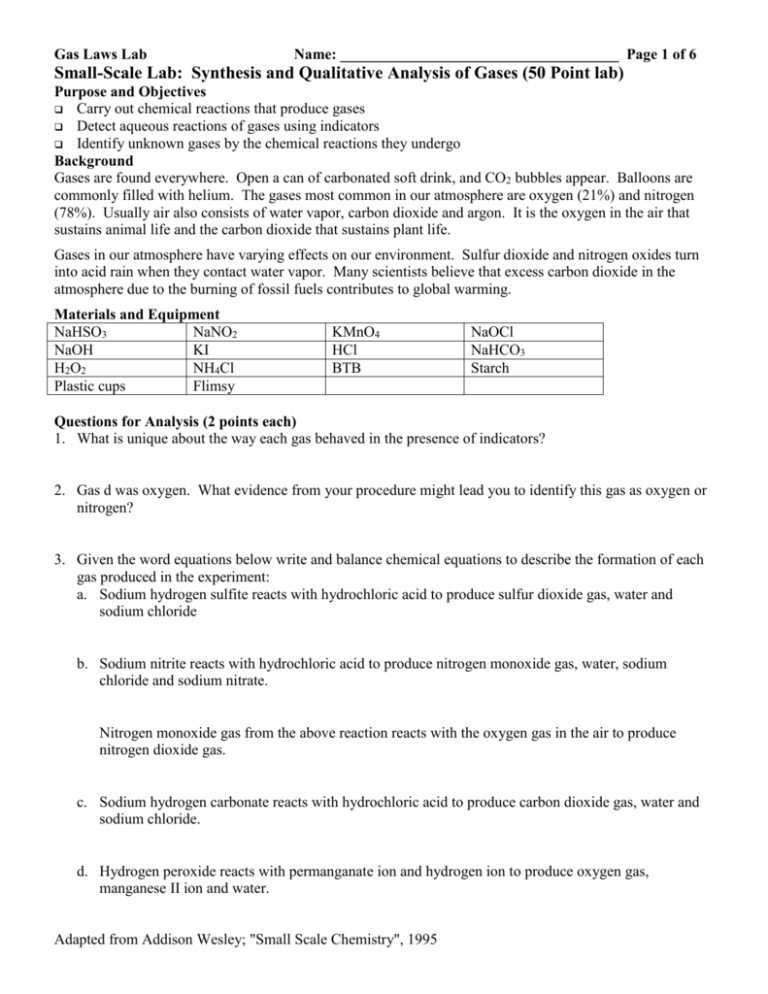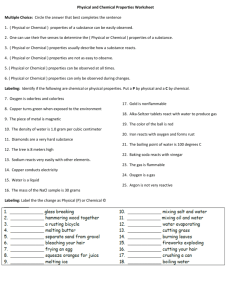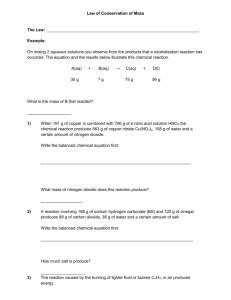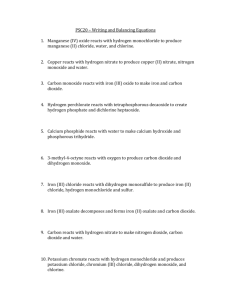Small-Scale Lab: Synthesis and Qualitative Analysis of Gases (SS15)
advertisement

Gas Laws Lab Name: _____________________________________ Page 1 of 6 Small-Scale Lab: Synthesis and Qualitative Analysis of Gases (50 Point lab) Purpose and Objectives Carry out chemical reactions that produce gases Detect aqueous reactions of gases using indicators Identify unknown gases by the chemical reactions they undergo Background Gases are found everywhere. Open a can of carbonated soft drink, and CO2 bubbles appear. Balloons are commonly filled with helium. The gases most common in our atmosphere are oxygen (21%) and nitrogen (78%). Usually air also consists of water vapor, carbon dioxide and argon. It is the oxygen in the air that sustains animal life and the carbon dioxide that sustains plant life. Gases in our atmosphere have varying effects on our environment. Sulfur dioxide and nitrogen oxides turn into acid rain when they contact water vapor. Many scientists believe that excess carbon dioxide in the atmosphere due to the burning of fossil fuels contributes to global warming. Materials and Equipment NaHSO3 NaNO2 NaOH KI H2O2 NH4Cl Plastic cups Flimsy KMnO4 HCl BTB NaOCl NaHCO3 Starch Questions for Analysis (2 points each) 1. What is unique about the way each gas behaved in the presence of indicators? 2. Gas d was oxygen. What evidence from your procedure might lead you to identify this gas as oxygen or nitrogen? 3. Given the word equations below write and balance chemical equations to describe the formation of each gas produced in the experiment: a. Sodium hydrogen sulfite reacts with hydrochloric acid to produce sulfur dioxide gas, water and sodium chloride b. Sodium nitrite reacts with hydrochloric acid to produce nitrogen monoxide gas, water, sodium chloride and sodium nitrate. Nitrogen monoxide gas from the above reaction reacts with the oxygen gas in the air to produce nitrogen dioxide gas. c. Sodium hydrogen carbonate reacts with hydrochloric acid to produce carbon dioxide gas, water and sodium chloride. d. Hydrogen peroxide reacts with permanganate ion and hydrogen ion to produce oxygen gas, manganese II ion and water. Adapted from Addison Wesley; "Small Scale Chemistry", 1995 Gas Laws Lab Name: _____________________________________ Page 2 of 6 e. Chlorine gas, water and sodium chloride are produced when hydrochloric acid is added to sodium hypochlorite. f. Sodium hydroxide reacts with ammonium chloride to produce ammonia gas, water, and sodium chloride. 4. Given the word equations below write and balance chemical equations to describe each reaction of a gas with an indicator or the water in the indicator. In each case explain the change in the indicator. a. Sulfur dioxide gas reacts with water in the BTB indicator to produce sulfurous acid. b. Sulfur dioxide gas also reacts with iodine and water to form iodide ion, sulfate ion, and hydrogen ion. c. Nitrogen dioxide gas reacts with water in the indicator to produce nitric acid and nitrous acid. d. Chlorine gas reacts with iodide ion to form iodine and chloride ion. e. Chlorine gas also reacts with water in the BTB to from hydrochloric acid and hypochlorous acid. f. Ammonia gas reacts with water in the BTB indicator to produce hydroxide ions and ammonium ion. Adapted from Addison Wesley; "Small Scale Chemistry", 1995 Gas Laws Lab Name: _____________________________________ Page 3 of 6 Experimental Page 1. Place 1 drop of each indicator solution in the squares near the inside edge of the each circle, and cover the entire circle with a Petri dish. Be sure the petri dish does not touch any solutions. 2. Observe any changes that take place over several minutes. Also observe the nature of the gas bubbles (if any) produced by the mixing. Gases produced by the mixing of the reactants in the center will cause some of the indicators to change color. Record your results and observations for each circle of reactions in a your lab report. Write a balanced equation to account for your observations. If you see bubbles then a gas is produced ORGANIZE your work. 25 Points 3. Neutralize the mixtures in the centers with a few drops of NaOH each; clean the reaction surface with a damp towel and dry it. Clean the cups with a dry paper towel to absorb stray gases. 4. Repeat step 3. And do the next mixing. 5. Reaction page is page 6. Put this in a file protector sleeve and drop the chemicals on the plastic sheet then cover with a Petri dish. The round plastic dishes on the counter by the first large plastic distilled water container. Adapted from Addison Wesley; "Small Scale Chemistry", 1995 Gas Laws Lab Name: _____________________________________ Page 4 of 6 Adapted from Addison Wesley; "Small Scale Chemistry", 1995 Gas Laws Lab Name: _____________________________________ Page 5 of 6 Small Scale Chemistry (50 Point lab) Reactions of Carbonates that Produce Carbon Dioxide Objectives Observe and identify the reactions of carbonates to produce carbon dioxide. Describe reactions of acids with carbonates by writing complete chemical equations. Introduction: The usefulness of chemical reactions isn’t in part being able to predict what products result from given reactants. Chemical reactions can be classified into general types, and these general types follow predictable patterns. One common property of acids is their reactions with the carbonate ion, CO32- to produce CO2 gas. Because carbonates react with acids to neutralize them, carbonates can be considered bases. Familiar antacids commonly employ sodium hydrogen carbonate, NaHCO3, or calcium carbonate, CaCO3 as active ingredients to neutralize stomach acid. Safety Wear safety glasses Use small scale pipets only for the carefully controlled delivery of liquids. Materials HCl HNO3 NaHCO3 (solid) H2SO4 NaHCO3 Hot plate Na2CO3 CH3COOH Slide H3PO4 CaCO3 (solid) Questions for Analysis (4 points each) 1. What are the gas bubbles you observed in each reaction of an acid with a carbonate? 2. Write the balanced reactions for all 17 reactions that took place in this experiment. For each reaction, write the name of the salt produced. 3. Study the equations in the previous question. Are the equations any different if the carbonates are solids or aqueous solutions? 4. What are two compounds that are always formed by the reaction of an acid with a carbonate? Adapted from Addison Wesley; "Small Scale Chemistry", 1995 Gas Laws Lab Name: _____________________________________ Page 6 of 6 Experimental Page For the reactions you see below write a net ionic equation. Organize your work so it is neat and easy to follow. Put this sheet in a plastic file protector sheet and do the reaction on the “X” so that it is on the white and the black. In your discussion of this part address the common factors of these reactions. (35 Points) Adapted from Addison Wesley; "Small Scale Chemistry", 1995








